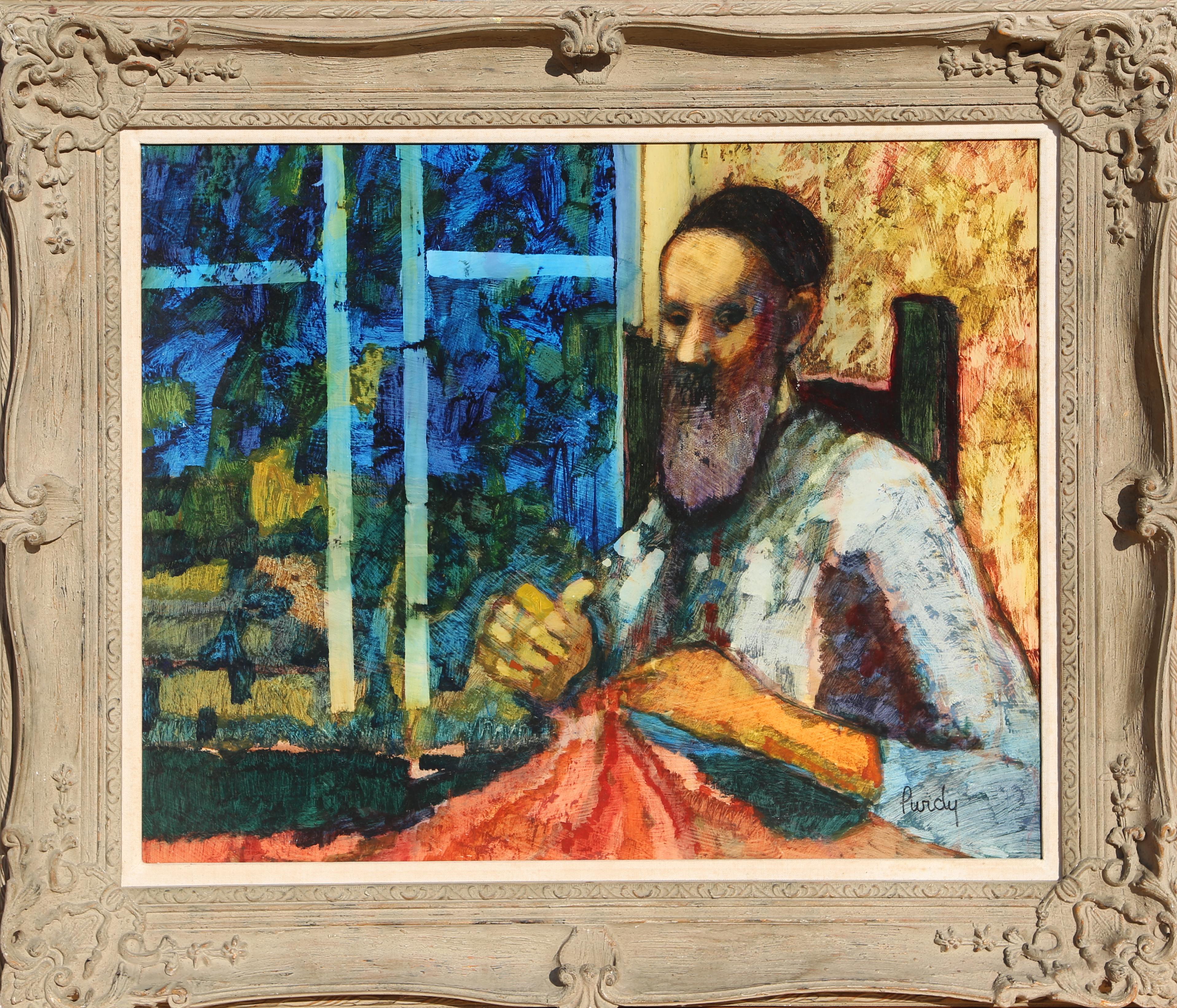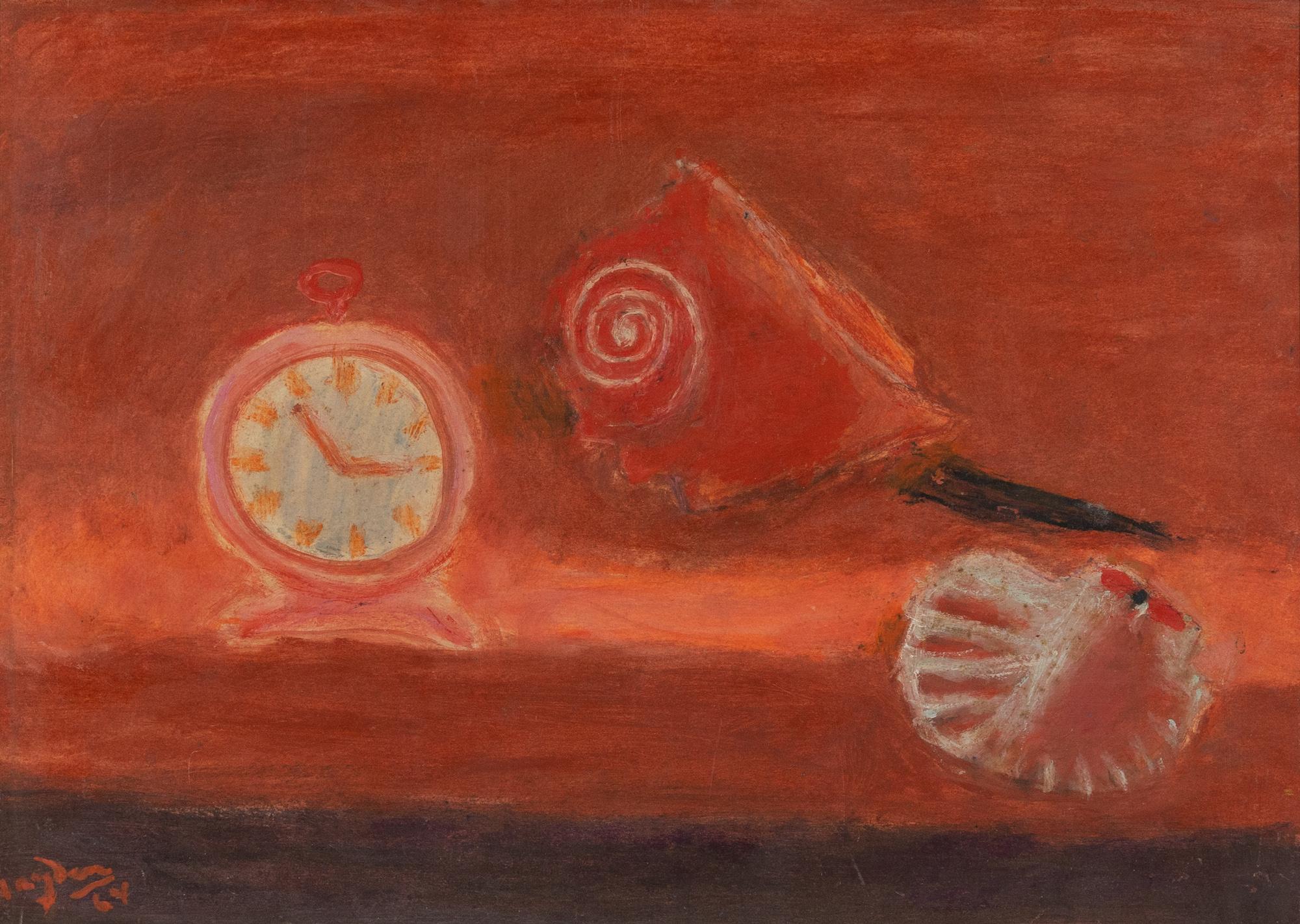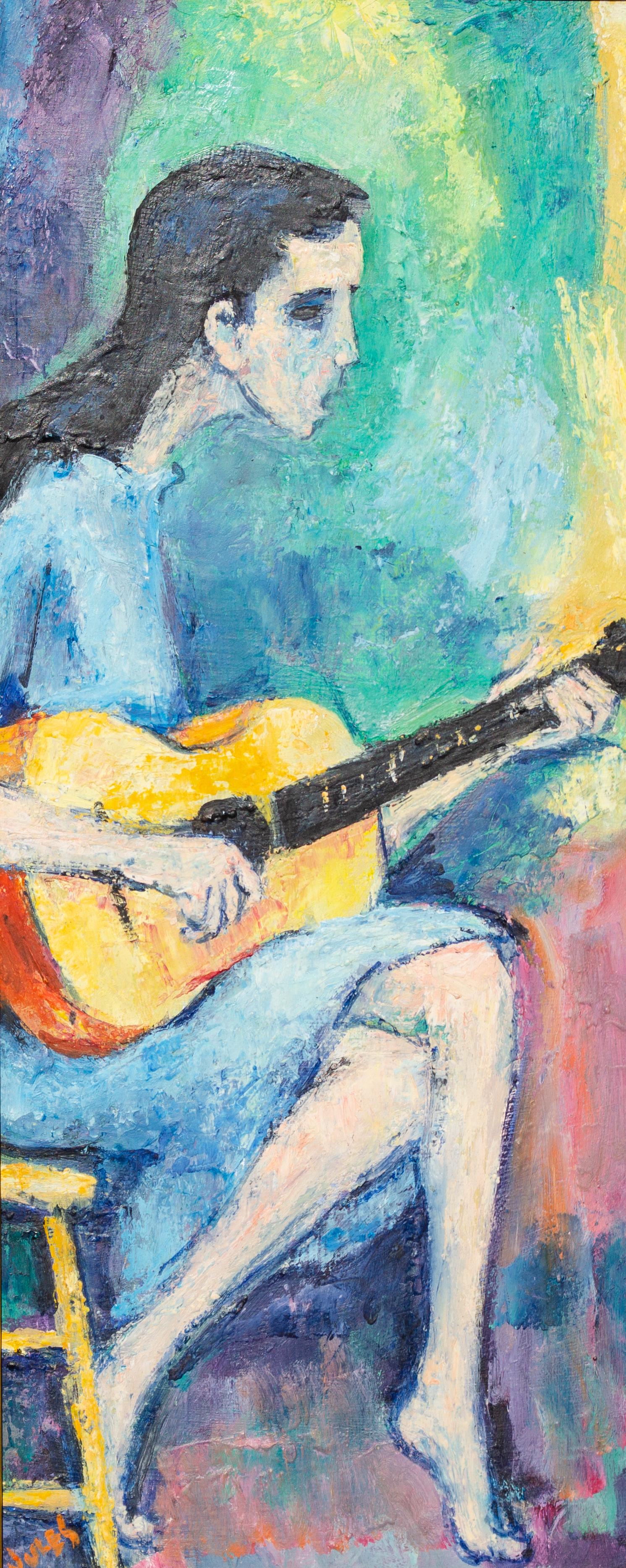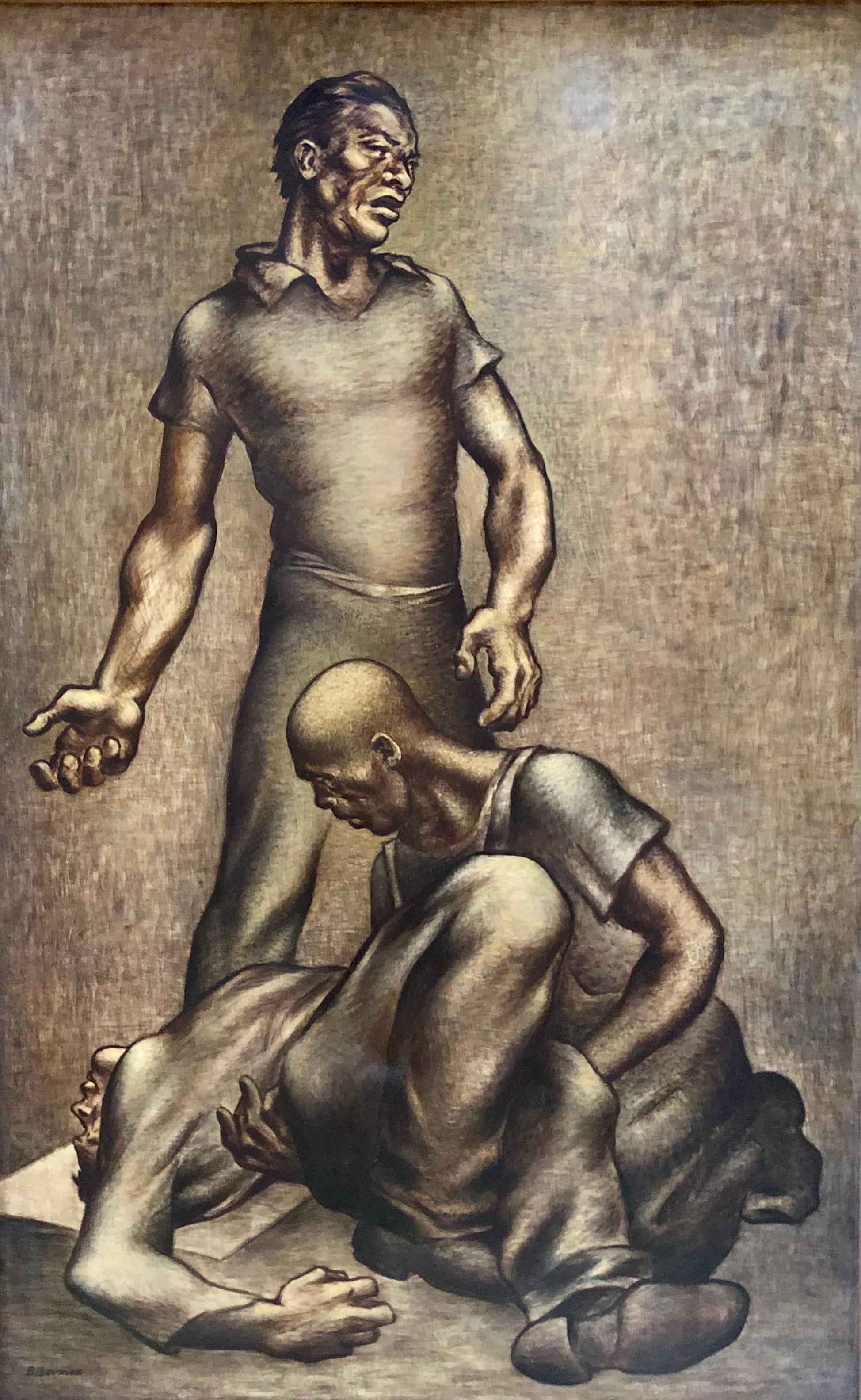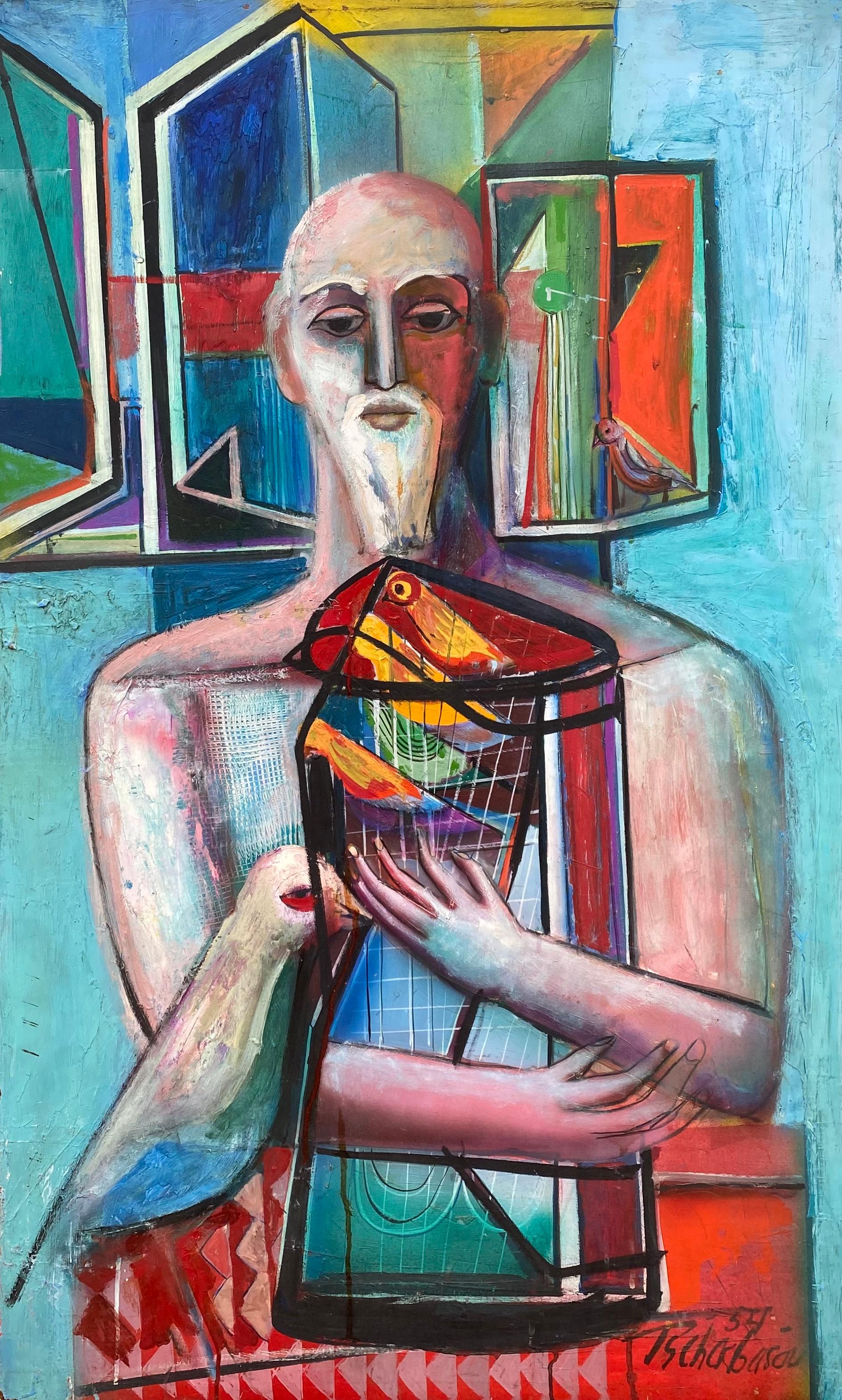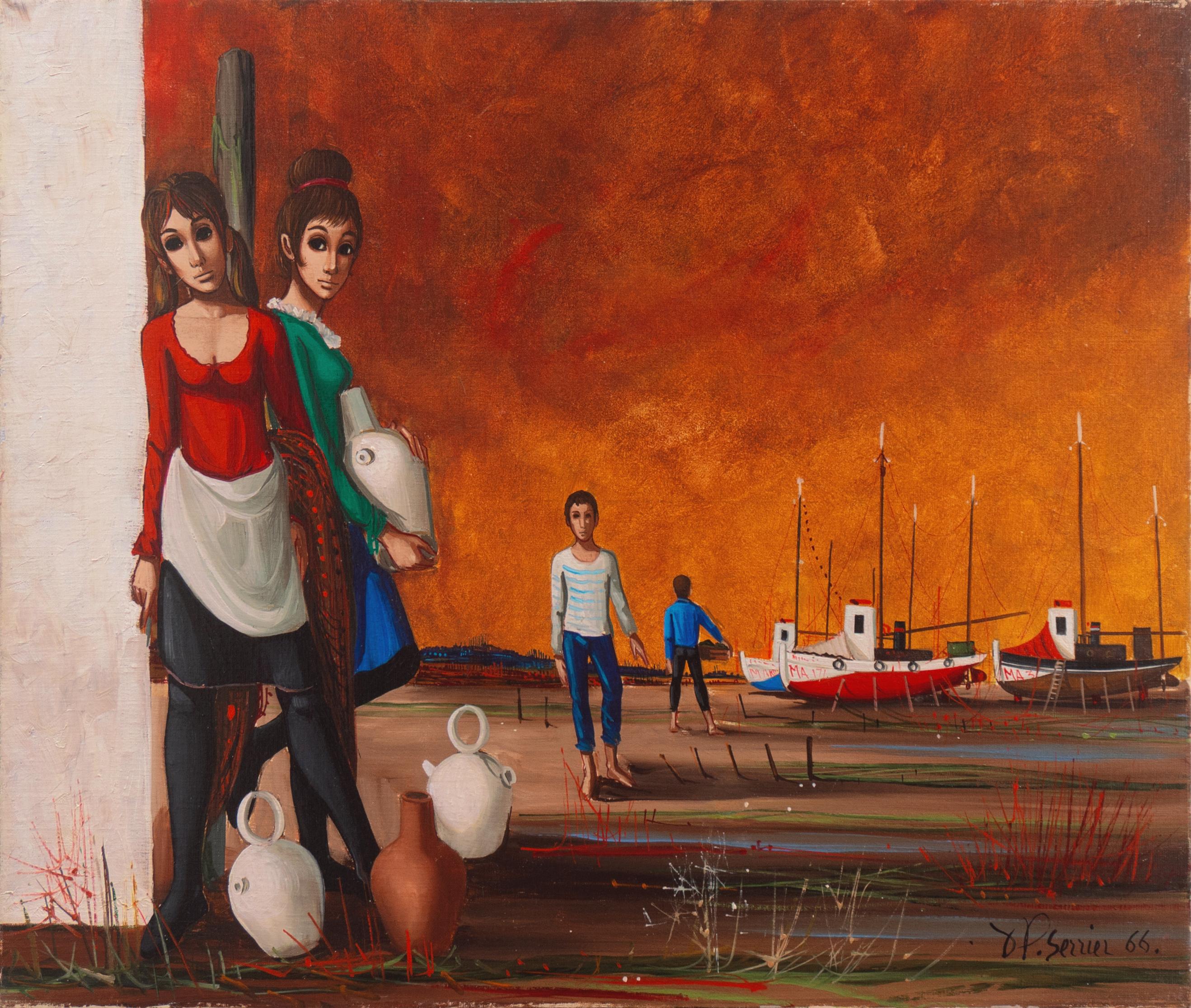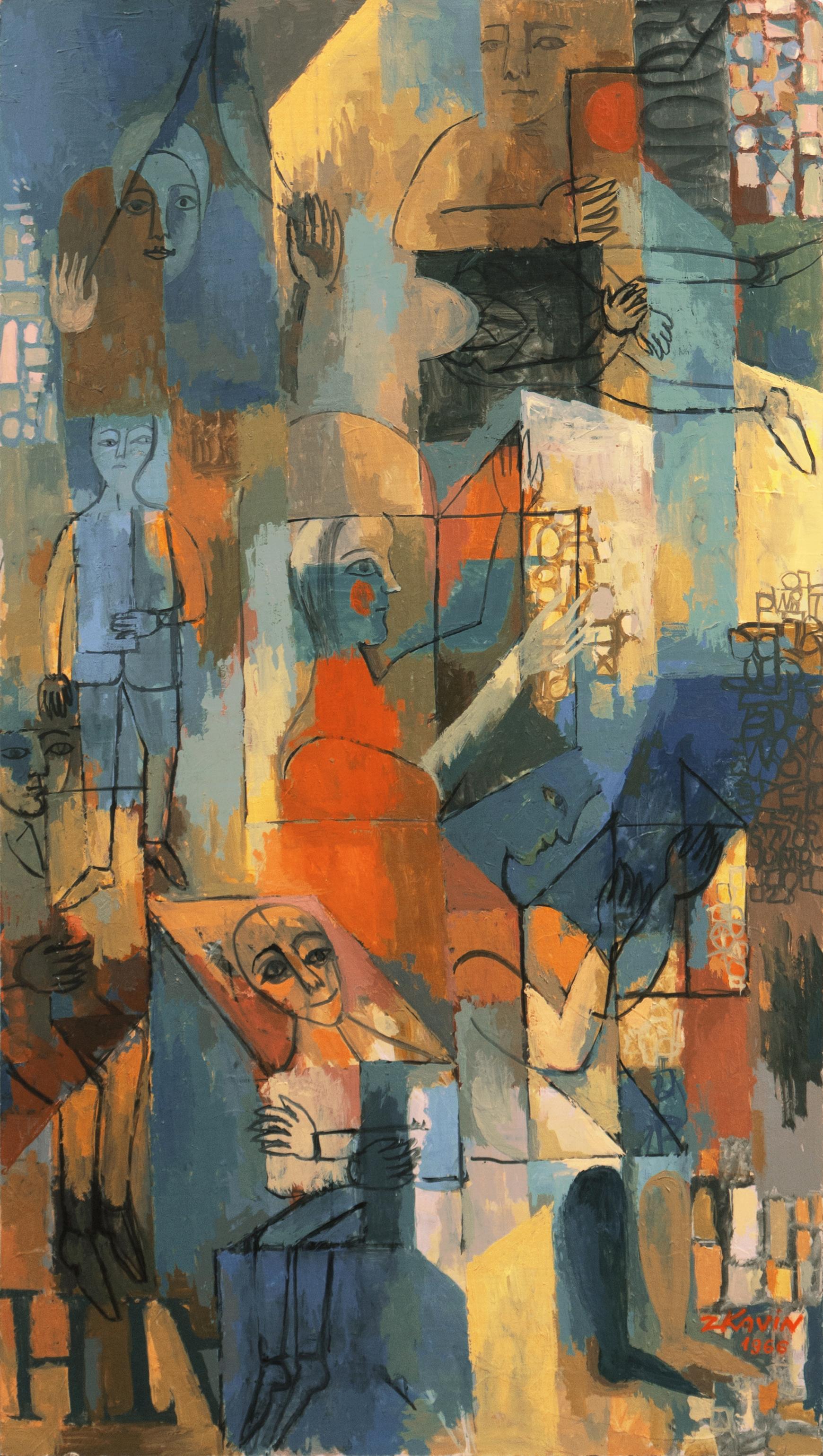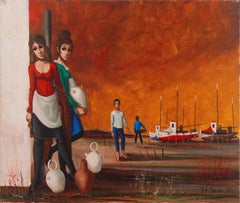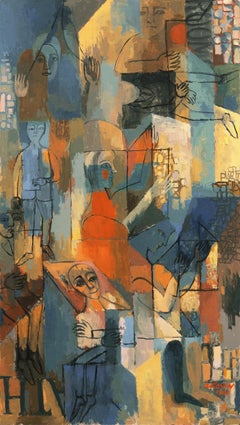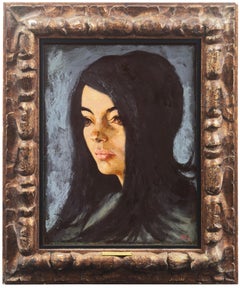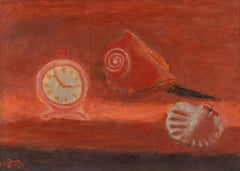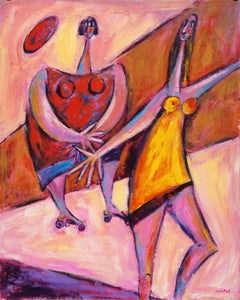
'Roller Skaters at Sunset', Post Impressionist Figural, Florida State Capitol
View Similar Items
Want more images or videos?
Request additional images or videos from the seller
1 of 11
Richard Seidel'Roller Skaters at Sunset', Post Impressionist Figural, Florida State CapitolCirca 1985
Circa 1985
About the Item
- Creator:Richard Seidel (1949, American)
- Creation Year:Circa 1985
- Dimensions:Height: 30 in (76.2 cm)Width: 24 in (60.96 cm)Depth: 0.13 in (3.31 mm)
- Medium:
- Movement & Style:
- Period:
- Condition:minor restoration, minor corner bumping; unframed; recently cleaned, shows well.
- Gallery Location:Santa Cruz, CA
- Reference Number:1stDibs: LU34412728832
About the Seller
5.0
Platinum Seller
These expertly vetted sellers are 1stDibs' most experienced sellers and are rated highest by our customers.
Established in 1982
1stDibs seller since 2013
639 sales on 1stDibs
More From This SellerView All
- 'The Water Carriers', Paris, Salon d'Automne, Académie des Beaux-Arts, New YorkBy Jean Pierre SerrierLocated in Santa Cruz, CASigned lower right, 'J. P. Serrier' for Jean Pierre Serrier (French, 1934-1989) and dated 1966 Jean-Pierre Serrier was born in Montparnasse and attended the Académie des Beaux-Arts ...Category
1960s Modern Figurative Paintings
MaterialsCanvas, Masonite, Oil
- 'Modernist Figural', California, New Mexico, Oakland Museum, SFAA, SFMA, GGIELocated in Santa Cruz, CASigned lower right, 'Z. Kavin' for Zena Kavin (American, 1912-2003) and dated 1966. Born in Berkeley, California, Zena Kavin studied at the California School of Fine Arts in San Francisco and, privately, with Kravchenko in Moscow. She lived in Berkeley and in Oakland her entire life, except for four years spent in New Mexico in the late 1930s. In 1949, she married artist Jon Cornin and settled with him in Oakland. Under the peudonym Corka, the Cornins produced cartoons for the Saturday Evening Post and the New Yorker. Kavin worked in various media, including wood engraving, lithography and sculpture. She was a member of the San Francisco Artists Association and exhibited with them as well as at the San Francisco Museum of Art Inaugural (1935), the California–Pacific International Exposition, San Diego (1935), the Golden Gate International Exposition (1939). Her work is held in the permanent collections of the Davis Art Center, the New Mexico Museum of Art and the Oakland Museum of California. Reference: Artists in California 1786-1940, Third Edition, Edan Milton Hughes: Crocker Art Museum, Sheridan Books 2002, Vol. 1, page 610; Who Was Who in American Art 1564-1975: 400 Years of Artists in America, Peter Hastings Falk, Sound View Press 1999, Vol. 2, page 1801; Mallett’s Index of Artists, Supplement, Daniel Trowbridge Mallett, Peter Smith...Category
1960s Modern Figurative Paintings
MaterialsMasonite, Oil
- 'Portrait of a Young Woman', Philadelphia Modernist, PAFA, Baum School of ArtBy Martin ZipinLocated in Santa Cruz, CASigned lower right, 'Zipin' for Martin Zipin (American, 1920-1991) and painted circa 1960. Displayed in the original, hand-carved giltwood frame. Framed ...Category
1960s Modern Figurative Paintings
MaterialsOil, Masonite
- 'Nuns at Notre-Dame', Paris, Munich, Woman Modernist, AIC, Smithsonian, CarmelBy Patricia Stanley CunninghamLocated in Santa Cruz, CASigned lower left, and lower right, 'Patricia Cunningham' for Patricia Stanley Cunningham (American, 1907-1984) and painted circa 1965. A vibrant, Post-Impressionistic oil showing a view of Paris with two nuns wearing wimples and cornets, one carrying a basket of daffodils, standing beneath the shade of a tree and with a view beyond to the facade of the Cathedral of Notre-Dame lit by bright sunshine. The first woman to serve as president of the Carmel Art Association, Patricia Stanley Cunningham first studied at UC Berkeley and, subsequently, with Hans Hofmann in Munich and with André Lhote in Paris. While in Paris, in 1930, she wed the American artist, John Cunningham. Settling on the Monterey Peninsula after returning from Europe, Cunningham joined the Carmel Art Institute, of which she became president, the Southwest Artists...Category
1980s Modern Landscape Paintings
MaterialsMasonite, Oil
- 'Montmartre, Place du Tertre', Paris, Woman Modernist, AIC, Smithsonian, CarmelBy Patricia Stanley CunninghamLocated in Santa Cruz, CASigned lower right, 'Patricia Cunningham' for Patricia Stanley Cunningham (American, 1907-1984) and painted circa 1965. The first woman to serve as president of the Carmel Art Assoc...Category
1960s Modern Landscape Paintings
MaterialsOil, Masonite
- 'Seated Nude with Flowers' Paris, Louvre, Académie Chaumière, SFAA, LACMABy Victor Di GesuLocated in Santa Cruz, CAAccompanied by certificate of authenticity for Victor Di Gesu (American, 1914-1988) and painted circa 1955. Additional painting, verso, with old inscription by the artist's wife, Jan...Category
1940s Post-Impressionist Figurative Paintings
MaterialsOil, Masonite
You May Also LikeView All
- Rabbi 3, 1970s Oil Painting by Donald Roy PurdyBy Donald Roy PurdyLocated in Long Island City, NYArtist: Donald Roy Purdy, American (1924 - ) Title: Rabbi 3 Year: circa 1970 Medium: Oil on Masonite, signed l.r. Size: 24 x 30 in. (60.96 x 76.2 cm) Frame Size: 34 x 39 inchesCategory
1970s Modern Figurative Paintings
MaterialsOil, Masonite
- Coquillage et réveil en rouge by Henri Hayden - Still Life PaintingBy Henri HaydenLocated in London, GBCoquillage et réveil en rouge by Henri Hayden (1883-1970) Oil on paper laid down on isorel 33.5 x 46 cm (13 ¹/₄ x 18 ¹/₈ inches) Signed and dated lower le...Category
1960s Modern Figurative Paintings
MaterialsMasonite, Oil, Laid Paper
- Mervin Jules Folk Singer Portrait, SignedBy Mervin JulesLocated in Larchmont, NYMervin Jules (American, 1912-1994) Folk Singer, 20th century Oil on masonite 18 x 7 1/2 in. Signed lower left: Jules Provenance: Garelick's Gallery, Detroit Matte included, no fram...Category
20th Century American Modern Figurative Paintings
MaterialsMasonite, Oil
- St. Atomic oil and tempera painting by Julio de DiegoBy Julio de DiegoLocated in Hudson, NYJulio De Diego’s Atomic Series paintings made an extraordinary statement regarding the shock and fear that accompanied the dawn of the nuclear age. In the artist’s own words, “Scientists were working secretly to develop formidable powers taken from the mysterious depths of the earth - with the power to make the earth useless! Then, the EXPLOSION! . . . we entered the Atomic Age, and from there the neo-Atomic war begins. Explosions fell everywhere and man kept on fighting, discovering he could fight without flesh.” To execute these works, De Diego developed a technique of using tempera underpainting before applying layer upon layer of pigmented oil glazes. The result is paintings with surfaces which were described as “bonelike” in quality. The forms seem to float freely, creating a three-dimensional visual effect. In the 1954 book The Modern Renaissance in American Art, author Ralph Pearson summarizes the series as “a fantastic interpretation of a weighty theme. Perhaps it is well to let fantasy and irony appear to lighten the devastating impact. By inverse action, they may in fact increase its weight.” Exhibited 1950 University of Illinois at Urbana "Contemporary American Painting" 1964 Marion Koogler McNay Art Institute, San Antonio, Texas This work retains its original frame which measures 54" x 36" x 2". About this artist: Julio De Diego crafted a formidable persona within the artistic developments and political struggles of his time. The artist characterized his own work as “lyrical,” explaining, “through the years, the surrealists, the social-conscious painters and the others tried to adopt me, but I went my own way, good, bad or indifferent.” [1] His independence manifested early in life when de Diego left his parent’s home in Madrid, Spain, in adolescence following his father’s attempts to curtail his artistic aspirations. At the age of fifteen he held his first exhibition, set up within a gambling casino. He managed to acquire an apprenticeship in a studio producing scenery for Madrid’s operas, but moved from behind the curtains to the stage, trying his hand at acting and performing as an extra in the Ballet Russes’ Petrouchka with Nijinsky. He spent several years in the Spanish army, including a six-month stretch in the Rif War of 1920 in Northern Africa. His artistic career pushed ahead as he set off for Paris and became familiar with modernism’s forays into abstraction, surrealism, and cubism. The artist arrived in the U.S. in 1924 and settled in Chicago two years later. He established himself with a commission for the decoration of two chapels in St. Gregory’s Church. He also worked in fashion illustration, designed magazine covers and developed a popular laundry bag for the Hotel Sherman. De Diego began exhibiting through the Art Institute of Chicago in 1929, and participated in the annual Chicago Artists Exhibitions, Annual American Exhibitions, and International Water Color Exhibitions. He held a solo exhibition at the Art Institute of Chicago in the summer of 1935. Though the artist’s career was advancing, his family life had deteriorated. In 1932 his first marriage dissolved, and the couple’s young daughter Kiriki was sent to live with friend Paul Hoffman. De Diego continued to develop his artistic vocabulary with a growing interest in Mexican art. He traveled throughout the country acquainting himself with the works of muralists such as Carlos Merida, and also began a collection of small native artifacts...Category
1940s American Modern Abstract Paintings
MaterialsMasonite, Oil, Tempera
- Inevitable Day – Birth of the Atom oil and tempera painting by Julio De DiegoBy Julio de DiegoLocated in Hudson, NYJulio De Diego’s Atomic Series paintings made an extraordinary statement regarding the shock and fear that accompanied the dawn of the nuclear age. In the artist’s own words, “Scientists were working secretly to develop formidable powers taken from the mysterious depths of the earth - with the power to make the earth useless! Then, the EXPLOSION! . . . we entered the Atomic Age, and from there the neo-Atomic war begins. Explosions fell everywhere and man kept on fighting, discovering he could fight without flesh.” To execute these works, De Diego developed a technique of using tempera underpainting before applying layer upon layer of pigmented oil glazes. The result is paintings with surfaces which were described as “bonelike” in quality. The forms seem to float freely, creating a three-dimensional visual effect. In the 1954 book The Modern Renaissance in American Art, author Ralph Pearson summarizes the series as “a fantastic interpretation of a weighty theme. Perhaps it is well to let fantasy and irony appear to lighten the devastating impact. By inverse action, they may in fact increase its weight.” Bibliography Art in America, April 1951, p.78 About this artists: Julio De Diego crafted a formidable persona within the artistic developments and political struggles of his time. The artist characterized his own work as “lyrical,” explaining, “through the years, the surrealists, the social-conscious painters and the others tried to adopt me, but I went my own way, good, bad or indifferent.” [1] His independence manifested early in life when de Diego left his parent’s home in Madrid, Spain, in adolescence following his father’s attempts to curtail his artistic aspirations. At the age of fifteen he held his first exhibition, set up within a gambling casino. He managed to acquire an apprenticeship in a studio producing scenery for Madrid’s operas, but moved from behind the curtains to the stage, trying his hand at acting and performing as an extra in the Ballet Russes’ Petrouchka with Nijinsky. He spent several years in the Spanish army, including a six-month stretch in the Rif War of 1920 in Northern Africa. His artistic career pushed ahead as he set off for Paris and became familiar with modernism’s forays into abstraction, surrealism, and cubism. The artist arrived in the U.S. in 1924 and settled in Chicago two years later. He established himself with a commission for the decoration of two chapels in St. Gregory’s Church. He also worked in fashion illustration, designed magazine covers and developed a popular laundry bag for the Hotel Sherman. De Diego began exhibiting through the Art Institute of Chicago in 1929, and participated in the annual Chicago Artists Exhibitions, Annual American Exhibitions, and International Water Color Exhibitions. He held a solo exhibition at the Art Institute of Chicago in the summer of 1935. Though the artist’s career was advancing, his family life had deteriorated. In 1932 his first marriage dissolved, and the couple’s young daughter Kiriki was sent to live with friend Paul Hoffman. De Diego continued to develop his artistic vocabulary with a growing interest in Mexican art. He traveled throughout the country acquainting himself with the works of muralists such as Carlos Merida, and also began a collection of small native artifacts...Category
1940s American Modern Abstract Paintings
MaterialsMasonite, Oil, Tempera
- The Magician oil and tempera painting by Julio de DiegoBy Julio de DiegoLocated in Hudson, NYJulio De Diego’s Atomic Series paintings made an extraordinary statement regarding the shock and fear that accompanied the dawn of the nuclear age. In the artist’s own words, “Scientists were working secretly to develop formidable powers taken from the mysterious depths of the earth - with the power to make the earth useless! Then, the EXPLOSION! . . . we entered the Atomic Age, and from there the neo-Atomic war begins. Explosions fell everywhere and man kept on fighting, discovering he could fight without flesh.” To execute these works, De Diego developed a technique of using tempera underpainting before applying layer upon layer of pigmented oil glazes. The result is paintings with surfaces which were described as “bonelike” in quality. The forms seem to float freely, creating a three-dimensional visual effect. In the 1954 book The Modern Renaissance in American Art, author Ralph Pearson summarizes the series as “a fantastic interpretation of a weighty theme. Perhaps it is well to let fantasy and irony appear to lighten the devastating impact. By inverse action, they may in fact increase its weight.” Exhibited 1964 Marion Koogler McNay Art Institute, San Antonio, Texas This work retains its original frame which measures 54" x 42" x 2" About this artist: Julio De Diego crafted a formidable persona within the artistic developments and political struggles of his time. The artist characterized his own work as “lyrical,” explaining, “through the years, the surrealists, the social-conscious painters and the others tried to adopt me, but I went my own way, good, bad or indifferent.” [1] His independence manifested early in life when de Diego left his parent’s home in Madrid, Spain, in adolescence following his father’s attempts to curtail his artistic aspirations. At the age of fifteen he held his first exhibition, set up within a gambling casino. He managed to acquire an apprenticeship in a studio producing scenery for Madrid’s operas, but moved from behind the curtains to the stage, trying his hand at acting and performing as an extra in the Ballet Russes’ Petrouchka with Nijinsky. He spent several years in the Spanish army, including a six-month stretch in the Rif War of 1920 in Northern Africa. His artistic career pushed ahead as he set off for Paris and became familiar with modernism’s forays into abstraction, surrealism, and cubism. The artist arrived in the U.S. in 1924 and settled in Chicago two years later. He established himself with a commission for the decoration of two chapels in St. Gregory’s Church. He also worked in fashion illustration, designed magazine covers and developed a popular laundry bag for the Hotel Sherman. De Diego began exhibiting through the Art Institute of Chicago in 1929, and participated in the annual Chicago Artists Exhibitions, Annual American Exhibitions, and International Water Color Exhibitions. He held a solo exhibition at the Art Institute of Chicago in the summer of 1935. Though the artist’s career was advancing, his family life had deteriorated. In 1932 his first marriage dissolved, and the couple’s young daughter Kiriki was sent to live with friend Paul Hoffman. De Diego continued to develop his artistic vocabulary with a growing interest in Mexican art. He traveled throughout the country acquainting himself with the works of muralists such as Carlos Merida, and also began a collection of small native artifacts...Category
1940s American Modern Abstract Paintings
MaterialsMasonite, Oil, Tempera
Recently Viewed
View AllMore Ways To Browse
Florida Art Oil
Florida Oil Painting
Vintage Florida Sign
Vintage Florida Signs
Art Painting Italian Post Modern
Californian Post Modern Artists
Miami Impressionist
Florida Impressionist Painting
Arles France
London Sunset
The Capitol
Irish Impressionist
1985 Hotel
Roller Vintage
Skaters Painting
Skating Paintings
Ohio Impressionist
French Impressionist Paintings Of Venice
